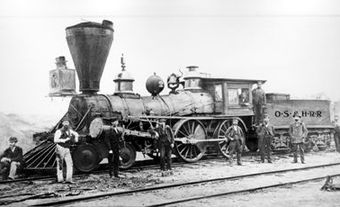
Railway Safety
Each year in Canada there are thousands of railway accidents. Most are minor and cause little damage and only a slight delay to the train. Some, however, result in injury, loss of life and substantial property damage. Canadian railways rank among the safest in North America. The incorporation of new technologies, such as welded rail, concrete ties and roller bearings on freight car axles, contributes to safe railways, as do centralized traffic control and electronic safety monitoring devices and better training of employees.
One of the most famous railway accidents in recent years was the 1979 "Mississauga Derailment". There were no injuries, but the accident involved leaking chlorine cars and forced the evacuation of 250 000 nearby residents. This, and a rash of similar accidents, served to focus public attention on railway safety, especially the problems of handling dangerous goods in urban areas. The ensuing Commission of Inquiry conducted by Mr Justice Samuel Grange made a number of sweeping recommendations regarding equipment design and inspection and train-operation procedures, especially for trains handling dangerous cargo such as poisonous or explosive gas. Many of these recommendations were subsequently imposed on the railways by the Canadian Transport Commission.
The other major accident was a head-on collision between a freight and passenger train at Hinton, Alta, in February 1986. Twenty-three people were killed, 71 hospitalized and $30 million worth of property damage done. This accident and a number of much less serious incidents again led to the appointment of a commission of inquiry, under Mr Justice René Paul Foisy. Mr Foisy found that the specific cause of the accident was the failure of the freight train to obey a stop signal. In more general terms, however, he was concerned that inadequate priority was placed on safety by many groups within the railway sector, including government. Many of the recommendations of the inquiry, especially those regarding crew rest and hours of work, were subsequently adopted by the CTC.
The accident has also given impetus to the investigation of some form of Automatic Train Control, which may be able to prevent such accidents in the future. While such standards have an impact on the possibility of derailments, collisions and other types of accidents, nearly 20% of all railway accidents, and most of the deaths, are at grade crossings, where driver behaviour plays an important factor. A complete but expensive solution for this type of accident is grade separation (overpass or underpass). There is an ongoing federal-provincial program to install signals and barriers at busy crossings.
The Railway Association of Canada and Transport Canada sponsor Operation Lifesaver, a national public safety program with an excellent record of reducing injuries and fatalities from accidents incurred at level crossings and from trespassing. The program involves railway staff, police and public service groups, who work together to increase public awareness of railway hazards, particularly those presented by level crossings. Collisions between trains and vehicles or pedestrians at rail crossings are as much a road safety issue as a railway issue. The majority of accidents at rail crossings are caused by drivers or pedestrians. Trains require considerable distance to stop, approximately the length of 14 football fields, and they cannot swerve to avoid an accident. Most level crossing accidents occur despite warning devices, and in fully one-third of vehicle/train collisions, the vehicle hits the side of the train.
See also disasters)

 Share on Facebook
Share on Facebook Share on X
Share on X Share by Email
Share by Email Share on Google Classroom
Share on Google Classroom

